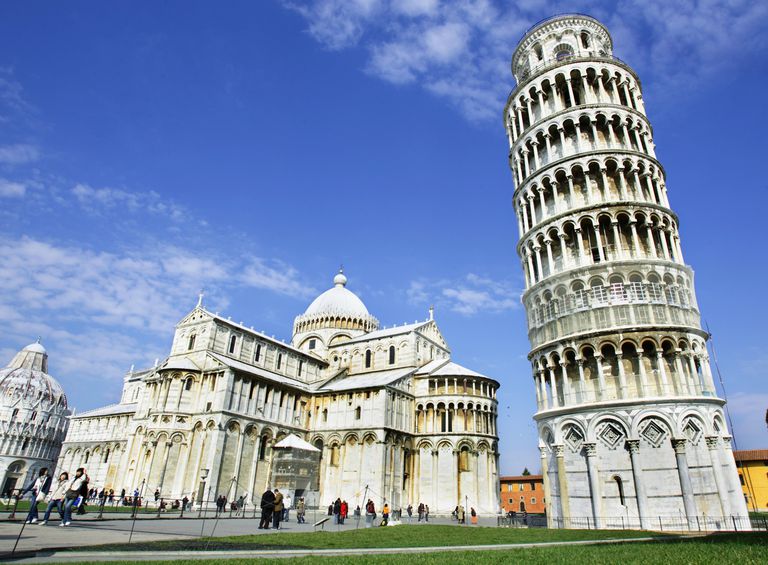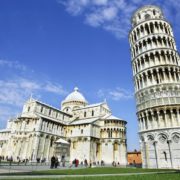Tower Troubles: Damaging Effect of Modern Efforts to Stabilize Tower of Pisa
Can we bring our most treasured art objects and buildings back to their original glory by modern restorations? In Italy, which has by some estimates forty percent of the world’s masterpieces, there has been a concerted campaign to do just over the past twenty years. As the Jubilee Year approaches, the urgency to clean every facade, all the public statuary, the fountains, and the paintings and sculptures in the great state collocations seems unbounded. The Tower of Pisa, one of the Seven Wonders, is the object of international attention and it offers an excellent place to obtain insight into the ongoing massive restoration operation. The tower started to lean even before it was finished and it has been leaning for almost 900 years. Since the early 19th century efforts have been made to stop the leaning process, perhaps as a result of confidence in modern technology. Following these interventions, however, an acceleration of the degree of pendency, much more than the previous 300 years, which only totaled about 5 millimeters, in effect no movement at all, has been measured. Still the leaning amounts to 1 or sometimes 2 millimeters a year. An imminent emergency does not seem to be the case, unless the recent interventions have provoked new dangers. Actually the collapse of Venice’s massive Campanile on July 14, 1902 (since rebuilt), which is sometimes used as a precedent for intervention in Pisa, was caused by the restorers of Sansovino’s Loggetta at its base, when they cut reinforment walls that had been added to support the tower in the mid-18th century after damage from lightning.
In fact, there is reason to believe that the efforts to correct what had been a fairly stable situation following the initial period of settlement on the sandy and muddy terrain back in the twelfth century, caused and continues to cause new instability. The latest efforts include the use of lead weights to counter the leaning. The placement at the base on the side opposite the leaning of nearly 1000 metric tons of lead at first appeared to have achieved the desired effect and a correction was registered. Then in a single day, known locally as Black Saturday on the night of 8-9 September 1995, most of the gain obtained in more than a year’s work (about an inch of correction) was almost entirely lost in a single day to the terror of all concerned, and work was stopped. What happened? One explanation is that the technical committee and its director discovered that in the 1930s certain work with cement and metal pipes had been undertaken, the existence of which they were unaware. This unexpected situation resulted in problems that had been be resolved. But more recently it has been admitted that the spectacular plan to freeze the ground using liquid nitrogen seemed to have, literally, backfired, in a lunar scene with orange gasses surrounding the tower. Keystone cops come to mind.
 This is hardly the occasion to argue complex technical issues, nor am I equipped to do so. What is remarkable about the entire situation surrounding the tower and the plans that have been announced recently (NY Times, January 7 ed. confirm date), is the total absence of a forum for discussion before action is taken. This unwillingness or inability to debate the health of our treasures, I suggests, characterizes most major restorations in Italy. If the nitrogen idea has been discussed openly and experts from outside the immediate group were invited to participate, the experiment would never have been undertaken in the first place.
This is hardly the occasion to argue complex technical issues, nor am I equipped to do so. What is remarkable about the entire situation surrounding the tower and the plans that have been announced recently (NY Times, January 7 ed. confirm date), is the total absence of a forum for discussion before action is taken. This unwillingness or inability to debate the health of our treasures, I suggests, characterizes most major restorations in Italy. If the nitrogen idea has been discussed openly and experts from outside the immediate group were invited to participate, the experiment would never have been undertaken in the first place.
Italian history since the Tower was begun back in 1173 has been characterized by the operation of clans, extended families, factions, and I suggestion that in the world of Italian restoration we have similar impenetrable, self-contained cliques. Criticism is not permitted. Worse still, there are no effective evaluations and controls of the work undertaken, the Committee that runs the multimillion dollar operation at the Tower of Pisa is totally independent. In fact, while in almost every other area of society, from films, theater, music, art, there is a tradition of criticism, with restoration no such habit exists and when it crops up, it is not tolerated. If it were, many would express consternation that there is now a project to fill in the centuries-old cracks in the massive walls of the tower (4 meters wide) with concrete. At the same time the use of concrete is known to have caused damage to the Perugia Fountain a half century ago, and its removal is being undertaken, in a laborious and expensive restoration. Keystone Cops? And even before there is anything like an assurance that the Tower will survive its caretakers, plans and funds are being ready for a proper cleaning of the marble exterior. Keystone Cops?
In an analogous situation, it is now widely accepted that the worst damage to the Basilica of San Francesco in Assisi last fall was the result of a restoration of the roof a generation ago, when the original timber supports were replaced by concrete ones. The concrete is heavier and more rigid, and while the seven hundred year old roof resisted previous quakes, the technologically modern one gave way. During the repairs now going on, water poured out from a hose in a work station over an entire week-end, actually dampened Giotto’s frescoes that had escaped the earthquake. Everyone knows that water is a greatest enemy of frescoes. Keystone Cops?
Around the same time, another medieval building, the Arena Chapel in Padua which contains Giotto’s mature work, underwent a substitution of their original timbers, but in this case metal beams were used. Giotto’s frescoes were not damaged during an earthquake in 1976 which was felt in Padua. But they are being damaged by humidity and the officials in charge seem quite unwilling to confront the question of the water in the crypt of the Chapel, which has been registered in recent years as being as much as 7 feet deep. Rather they plan to filter the dust and the moisture from tourists in a “scientific entrance way” constructed for the purpose. Keystone Cops?
The larger issue seems clear enough, and rest upon a simple assumption: works of art of the importance of the Basilica of San Francesco and its decorations, the Arena Chapel with Giotto’s frescoes, the Tower of Pisa, belong to the entire world. Decisions over their health, life and death decisions, should be undertaken with the greatest transparency and ample discussion, where all alternatives are considered before any course of action is taken. As with normal medical practice, second and third opinions should be solicited. No single entity or committee should have absolute control and be the absolute judge of their own activity but should be directed and should be responsible to a larger set of controls. We need a system of checks and balances to assure the most reliable results. Only in this way can we be guaranteed that these rare productions of mankind are not treated as if participants in an opera buffa.

